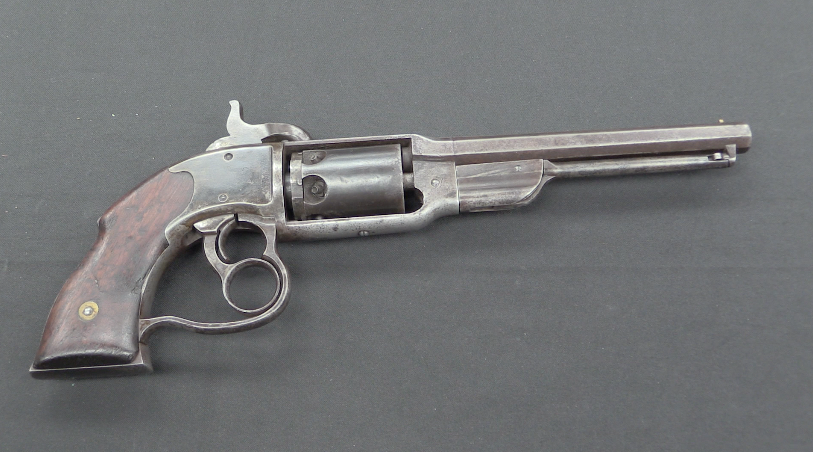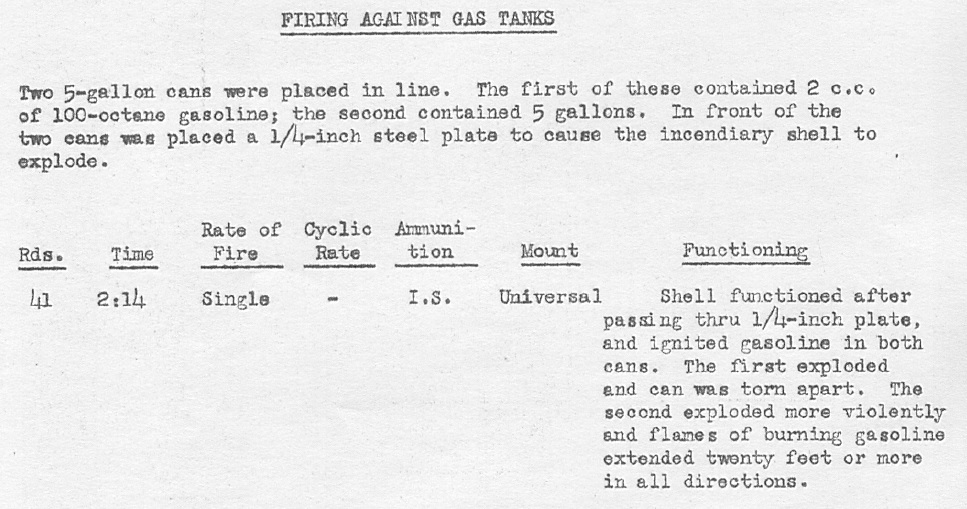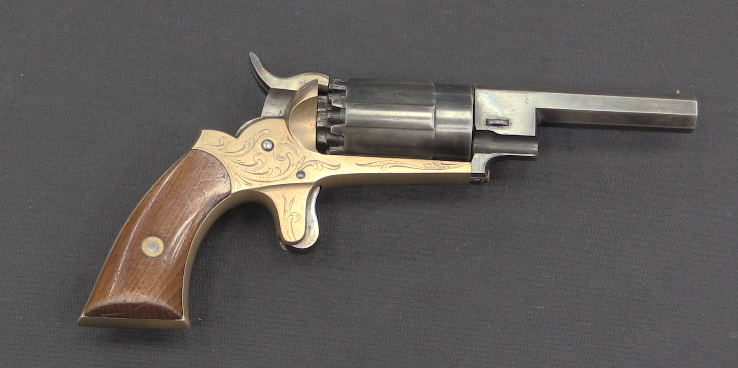An excerpt from Guns on the Early Frontiers, on the subject of Spanish matchlock muskets in the colonial Americas:
In 1576, a Captain Solis, commander of the Garrison at San Felipe, in the vicinity of what had been the Port Royal of the French Huguenots, executed two Indians, one a chief. Also, Solis had demanded that the neighboring Cusabo bring to the garrison a quantity of of corn and other provisions. Because the food was not promptly forthcoming, the Captain dispatched Moyano and twenty-two soldiers to the Indian villages to seize the needed corn. As the party approached one of the towns, some natives came out to meet it. They explained that their women and children were terrified by the burning slow match carried with every gun, and they indicated that they would cooperate if the soldiers would extinguish their matches. Moyano complied with the request, whereupon the Indians immediately killed all but one of the Spaniards and took the captured matchlocks to the Cusabo town.
Source: Swanton, John R. Early History of the Creek Indians and Their Neighbors. Washington. Bureau of American Ethnology, Bulletin 73, pp 58-59.
I should also point out that the Spanish were the most notorious colonists in the Americas when it came to subjugation and mistreatment of native tribes, and also the most diligent in working to prevent those tribes from acquiring firearms (weird how those go together). Of course, as one might expect, the tribes were able to acquire arms regardless…




There’s an interesting story in “Empire of the Summer Moon”, which is about the Commanches and their most famous leader, Quanah Parker.
In the 18th (I believe) century, a group of Apaches agreed to accept Spanish rule in a particular area if the Spaniards would establish a presence and “protect” them. As it turned out, the Apaches were actually snookering the Spanish into invading the “Commancheria” (realm of the Commanches) and fighting the Apaches’ (who like virtually EVERYBODY else, White AND Indian, HATED the Commanches) battles for them. As usual, things turned out badly for the Spaniards.
According to the book, it was ONLY the introduction of large numbers of repeating firearms, such as Colt cap and ball revolvers, which allowed their opponents to hold their own (never mind prevail) against the Commanches.
And speaking of not fighting “fair”, it was really only the intentional slaughter of the Commanche horse herds by General Crook and others, which finally broke their power. They were an almost entirely horse based economy. Without horses, the society (which even other Indians considered primitive) withered and died.
Regarding a horse-based society, there were no horses in the Americas before the Europeans came…then some tribes collapsed when they were deprived of horses. The Spaniards were invincible with matchlocks, helplesss without them. There is a lesson in there somewhere about adopting some advantage, technological or otherwise, to great advantage then suffering collapse if that singular advantage is lost.
Not all the Spaniards were bad, e.g., Antonio de Montesinos stood up against the abuse of the native Americans and arguably developed the concept of universal human rights (in that case, rights due everyone without regard to their religion.)
In general, the Spainards wanted to get rich and go back to Spain, the English wanted to settle in and stay. That may have had very different short and long term consequences.
Actually, against the Commanches, the Spaniards were FAR from “invincible”. A Commanche on horseback with a bow was FAR more effective than a Spaniard with an arquebus or even a miquelet musket.
Until repeating firearms and later metallic cartridges came along, the Commanches were essentially untouchable, except when they made their rare tactical blunders.
Equestrian Indians in Argentina were conquered–and mostly annihilated–by metalic cartridge breech-loaders, mostly the Remington rolling block in .43 Spanish.
Presidial soldiers in the late 18th and early 19th centuries would frequently fight as mounted infantry or “Dragoons.” There were also the heavily armed “soldados de cuera”:
Leather shield copied from the Moors, aka. adarga, akin to equestrian Plains Indian/Comanche/Lakota shields.
Leather buff coat armor or quilted Mexica/Aztec style armor
Espada ancha/short sword or saber
8ft. long lance
“Escopeta” or miquelet or flintlock carbine
Brace of flintlock pistols
A swift horse.
The Spaniards essentially dominated and exploited fully-sedentary Indian societies, i.e. farmers like in New Spain/Mexico and Perú. Non-sedentary peoples like the Apaches and Comanches and Tehuelches, etc. not so much.
Unlike the Aztecs and many more obscure Indian societies, the Commanche had no fixed capital. To a large extent, they were like the Mongols with no Chingiz Khan and no Karakorum. Their economic base was inherently mobile. If you could get them to stand and fight, musket armed European troops could prevail. Unfortunately for the Spaniards (and initially Texas and the United States), they hardly ever played to their enemies’ strengths. The Commancheria was of such a vast area, and so inhospitable to pre-mid 19th century White men that the Commanches were essentially inviolate and able to chose the time and place of engagement until Crook decided to fight a Civil War sort of “total war” against them. Crook took a page from Sherman and simply made it impossible for the Commanches to support themselves logistically, never mind fight effectively.
” There is a lesson in there somewhere about adopting some advantage, technological or otherwise, to great advantage then suffering collapse if that singular advantage is lost.”
You wouldn’t be referring to the leveraged power of the US Dollar would you?!
Good comment!
It makes me think of ages of waves, one after the other…. like in sea. Some small, some big; all disappeared in order to make space for new. We are just one of them.
Fighting fair, fighting un-fair, saying we are right or admitting we are wrong….will it make any difference?
Please correct me if I am interpreting this wrongly, but I think you are essentially saying that in the bigger scheme of things ( as in terms of historical or geological antecedent ), our human pre-occupation with the here and now is relatively insignificant, allowing for the fact that small factors can collectively add up in determining the whole to some degree. If so, I must admit I am in agreement with you and Gary Olson.
In San Antonio, Texas, the Spanish archives are filled with all kinds of anecdotes about violent encounters on the far frontier between missionaries, presidial troops, “Lipanería”–Lipan Apaches/Tinde, the Huichíta/Wichita, and “Comanchería”–the fearsome Comanche/Nemene.
There are lists of trade goods given to hostile Indians. These include very many large trade knives [“belduques”], axes, razors and so on, and while ramrods for muskets are common, guns are indeed very rare.
23. John Underhill, a Connecticut Puritan wrote in his last will and testament the following passage about his role in the 1637 war against the Pequot Indians where the English colonists and Narragansett allies fell upon a village in winter:
They know nothing of our coming. Drawing near to the fort, we yielded up ourselves to God and entreated His assistance in so weighty an enterprise. … Many were burnt in the fort…Others forced out…which our soldiers received and entertained with the point of the sword. Down fell men, women and children; those that ‘scalped us, fell into the hands of the Indians that were in the rear of us. It is reported by themselves, that there were about four hundred souls in this fort, and not above five of them ‘scaped out of our hands … Should not Christians have more mercy and compassion? But I would refer you to David’s war. … Sometimes the Scripture declareth women and children must perish with their parents. Sometimes the case alters; but we will not dispute it now. We have sufficient light from the Word of God for our proceedings According to Howard Zinn, (p.13), William Bradford described the raid in these terms: Those that ‘scaped the fire were slaine with the sword; some hewed to peeces, others [run through] with their rapiers [a type of sword], so as they were quickly dispatchte, and very few escaped. It was conceived they thus destroyed about 400 at this time. It was a fearful sight to see them thus frying in the fyer.
From such passages, one may infer
A. The English also used calculated terror and massacres of noncombatants in warfare against the Indians.
B. The goals of war by settlers often were to exterminate hostile Indians and take over possession of the land.
C. English settlers typically treated Indians with greater lassitude and fair play than other European colonists.
D. All of the above.
E. Only A and B.
While Cortez had little dificulty with the centralized empire of the Aztecs, and Pizarro with the centralized empire of the Incas
The decentalized Apache, who were forced by the Spanish to adopt a nomadic existence – took over 200 years to conquer
and that only happened by offering money and positions in order to corrupt their system of consensual leaders.
I forget who was supposed to have said; “if you ever find yourself in a fair fight – you’ve screwed up”
“if you ever find yourself in a fair fight – you’ve screwed up”
Truer words were never spoken.
I worked on the project to procure the anti-mine plows used in the First Gulf War and the Iraq War. I’ve always believed that if you give a new piece of equipment to a GI, he will either destroy it or find a way to use it entirely unanticipated by anyone involved in the procurement process. When faced by Iraqi forces in entrenched positions and bunkers, tankers merely used the plows to bury the Iraqis in their own positions. At the time, leftists in usenet expressed outrage that we’d do something so “unfair”. I just laughed at them, especially the Brits, and asked them if they thought it “unfair” for the tankers at Cambrai to pivot steer on the German positions.
A qualifier: Cortez had *considerable difficulty* with the Aztecs. La noche triste casualty rates? Investment and siege of Tenochtitlan?
Tens of thousands of Tlaxcaltec and other anti-Aztec/Mexica allies.
An interesting contrafactual:
What if the British (or French or the Chinese) had gotten there first and provided the Aztecs with matchlock firearms in exchange for material or political considerations?
Certainly the Chinese have never chosen their allies and trading partners based on abstract notions of morality…
Chris,
there has to be at least a book or three in that 🙂
For one thing, if Spain had not been able to loot the Aztec and Inca gold and silver, it would probably have a much sounder economy today.
The loot approximately doubled the money supply in Europe, with no commensurate increase in goods and services (it caused price inflation – as present day “Quantitative easing” will too).
The precious metal coming into Spain resulted in Spaniards importing their ordinary and luxury goods rather than making them at home (where all prices, including the price of labour had risen – while prodcutivity had dropped).
Sounds familliar? PIIIGS r US.
In actual history, the Chinese had got to the cape of Good Hope, before the portuguese – but a rival mandarin faction had gained ascendency and those mandarins saw their future in doing tax and authoritarianism harder at home rather than free trading internationally … sounds familliar too.
Indeed, what if Pizzaro had found the Incas drinking tea from Chinese porcelain, and wearing Japanese swords – and the Brits had found the chinese door closed to opium, as the mandarins already preferred crack, and the blue collar workers liked a brand of cigarettes that came in a packet with a picture of a man sat on a llama wearing an inca woolly hat?
If Chinese families had seen the future, not as getting a son to pass the entrance exam to the crack smoking, thieving, parasitic mandarin class, but in getting a productive job with a manufacturer or a merchant…
The industrial revolution might have started sooner – and started in China.
Very good point, Chris —- and, if we look closely at the facts behind history, very few, if any, countries or their governments ( of any stripe or declared belief system ) have actually based their true motives toward action on a real notion of morality at any time. There has nearly always been some sort of self-interest involved, whether it be short-term or long-term, direct or indirect. The only difference is how well they cloak it in terms of a higher, more noble cause and convince others accordingly. As I have said before, that is human nature at work in the larger picture.
Respectfully, look at the actual number of arquebus firearms and even small cannon along on the Cortez expedition… No denying the “shock value” of firearms in a stone age society using atlatl spear-throwers and slings as ranged projectile weapons.
The most lethal and fearsome ranged weapon the Spaniards possessed in the 1519-1525 conquest of central México was the crossbow. The Aztec had nothing comparable for sure. Guns, germs, and steel were all important, of course, but the Spaniards counted on tens of thousands of Indian allies. In fact, most Indian wars counted on the collaboration of native allies and/or auxiliaries. The “racial wrong” was only “discovered” in the 20th century…
I fully agree with David. Spanish steel and crossbows (and armoured horsemen, btw), wreaked havoc among Aztec warriors and ‘civilians’ alike. I must also add the fact that pre-Columbian, Mesoamerican warfare was a highly ritualised affair and the same is generally true about Andean societies at the time of the Pizarro onslaught.
Keith, your point about the huge difficulties in overcoming a decentralized opponent rings so true — we would all do well to remember that the current infrastructure of Al-Qaeda is set up in exactly that manner, a deliberate and strategically sound move on the part of Osama Bin Laden and his cohorts relative to their envisaged mission. It is not impossible to overcome and defeat this sort of set-up, but it must be understood that a great deal of long-term persistence, massive resources and plain unrelenting hard work on all fronts ( political, military, socio-economic, religious, et al. ) will have to be applied towards this issue if a real permanent or semi-permanent solution is to be achieved. All concerned also must understand that many casualties and much disruption will be part of the price to be paid along the way.
One of the biggest problems here in the U.S. is that people — the general populace, Congress, the House Of Representatives and Federal Government alike — are constantly looking for the magic one-size-fits-all [ or one-shot-kills-all, this being FW:) ] solution, otherwise known in the popular press as the so-called “silver bullet”. We all know that this is a fallacy that is completely at odds with harsh reality, yet most seem to insist on persisting with the idea, witness the current attitude that drone strikes will in themselves effectively suppress the enemy. The British learned the hard way during Colonial times that this sort of singular short-term approach did not work, and wisely applied the lessons learned towards the Mau-Mau Rebellion in Kenya ( still a subject even today of controversy, although few doubt that it achieved its intended goals of quelling the uprising and helping restore peace and stability ) and the Malayan Emergency ( which most knowledgeable historians agree was a model for successfully addressing the complex root causes of an indigenous insurgency ). In both cases, it took many years and much hardship and bloodshed, but the end result was a largely successful termination of the insurgencies involved and the emergence of a more stable socio-political-economic infrastructure that has lasted to this day, resisting all attempts at re-kindling the fires of the original rebellions. Having said that, it should be noted that it often only takes a certain amount of uncaring neglect combined with bad political timing to set any country back completely, negating all the hard-won progress that has gone before. That is an unfortunate aspect of the human condition.
“If you find yourself in a fair fight, your tactics suck.”
― John Steinbeck
Lars
thanks for the attribution – that’s the one I was trying to think about.
I’m sorry – the most notorious? As compared to the English, who didn’t colonize, they exterminated?
George Washington was known as the Town Burner by native Americans. The tactic of burning Native American towns in winter when lack of shelter and supplies killed them.
Kit Carson led a US military group with two small cannon on a winter raid against the Comanche. The cannon kept the Comanche from closing on horseback, and they burned villages destroying winter supplies. I believe this led to a treaty.